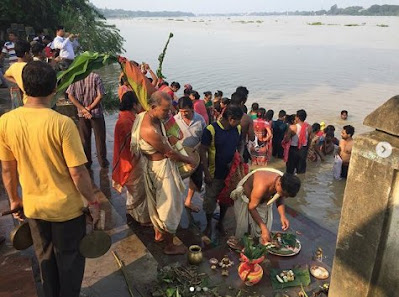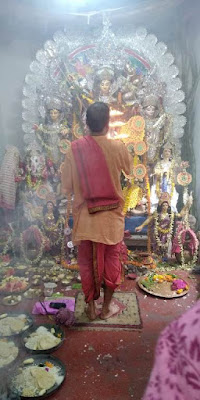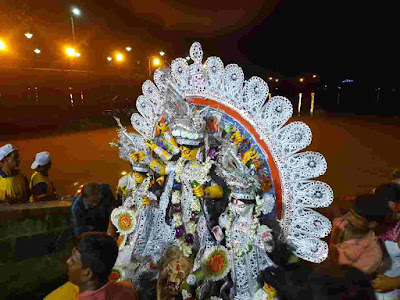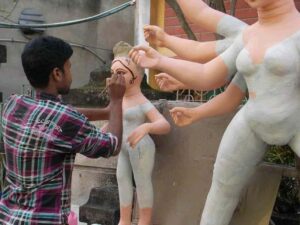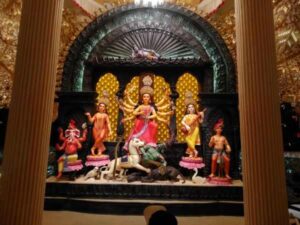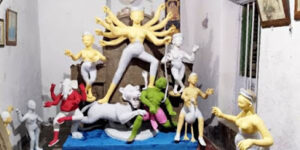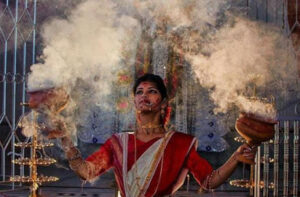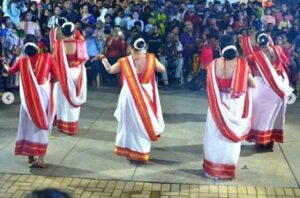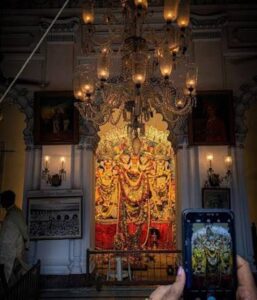Durga Puja, the biggest festival for Bengalis, is not just about theme pandals, glitzy lights, and beautiful idols. Rituals are an essential part of the celebration.
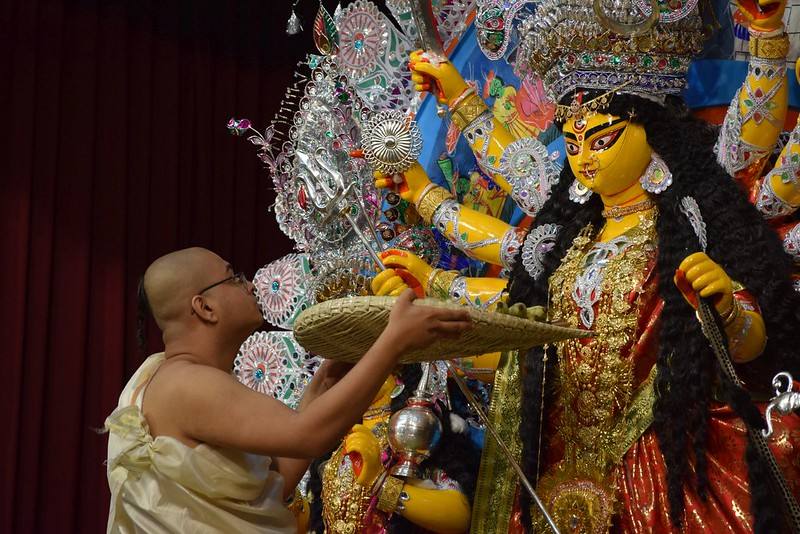
Bengalis worship Goddess Durga in the form of a daughter. Every year She visits her parent’s home along with her children for four days. They receive the treatment of honored guests who have arrived at the site of worship after a long journey. These four days marks the Durga Puja celebration for Bengalis.
Chokkhu Daan On Mahalaya
On the day of Mahalaya, the sculptor paints the eyes of the Durga idols. Chokkhu Daan means to donate eyes. This ritual marks as inviting the Goddess to arrive on earth. On the auspicious day of Mahalaya, Maa Durga begins her journey from Her abode Mount Kailasha. Her children Laxmi, Saraswati, Karthik, and Ganesha, come along on the trip.
Akal Bodhan On Sashthi
The ceremony of Bodhan is performed before puja celebrations to mark the auspicious appearance of Devi Durga. Lord Ram had invoked the Goddess in the month of Ashvin by performing her puja six months before the time of her worship to defeat Ravana. Read the full story of Durga Puja.
Lord Brahma had helped Ram by awakening goddess Durga on the day of Sasthi, beneath a Bel(wood apple) tree. Similarly, on Mahasashthi, the priest awakens the Goddess into a branch of a wood-apple(Bel) tree.
Since Rama had awakened the Goddess untimely, it is called Akal Bodhan (untimely awakening).
On Maha Sasthi, the day starts with the Kalparamba ritual in the early hours of the morning. An oath(Sankalpa) to conduct the puja, abiding by all the rites and customs is taken. Kalash(Ghata) installation takes place on the mandap or Pandal, and the Divine Mother is worshipped to awaken.
When the idols are brought in the Pandal, their faces remain covered. At dusk on Sasthi, the unveiling of the face of Goddess for the devotees signifies the deity coming alive.
Nabapatrika / Kola Bou Snan on MahaSaptami
On Saptami morning, Goddess Durga is invoked in a cluster of nine plants bunched together, called Nabapatrika. These nine plants Banana, Colocasia(Kochu), Turmeric, Jayanti, Bel leaves, Pomegranate leaves, Asoka leaves, Arum(Maalkochu) plant, rice paddy, represent the nine forms of Goddess Durga.
The Nabapatrika is given a pre-dawn bath in the nearby pond or river by the priest. Next, Nabapatrika is draped in a red-bordered white sari with vermilion smeared on its leaves to resemble a woman. Nabapatrika is also called Kola Bou(Banana bride).
All this time, Dhakis play the dhak, and women blow the conch shell and make ullu sound. The priest himself holds the Kola-Bou and brought it back to the Pandal. He places it on the right side of Maa Durga next to Lord Ganesh.
Kola Bou is popularly known as the wife of Ganesha, but it is not correct. The Navapatrika is none other than Durga herself. In the old days, peasants used to perform this ritual for a prosperous harvest.
Next, the priest places a mirror in a large bowl such that the face of the Goddess reflects on it. Water is then poured in it, to give a symbolic bath to the Goddess.
Kumari Puja On Mahaashtami
Kumari Puja is a major attraction of the Durga Puja festival in Bengal. It celebrates the young girls as a form of divine Mother.
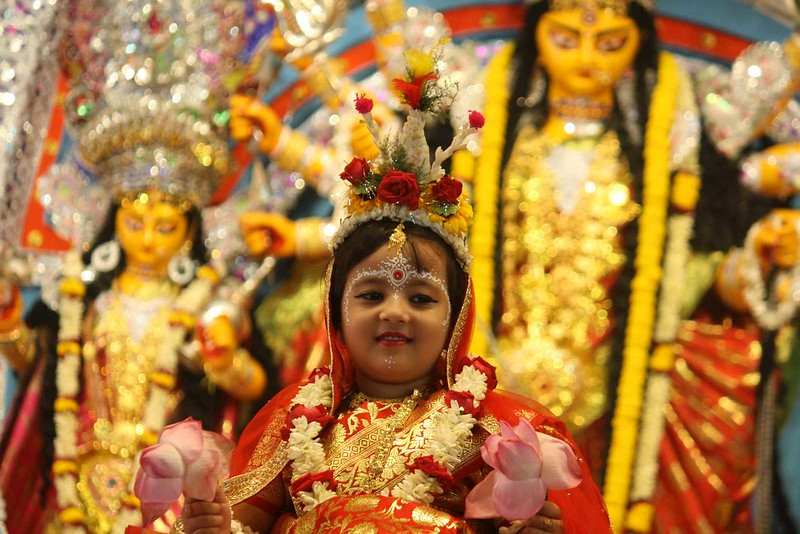
Swami Vivekananda started the Kumari Puja at Belur Math as a mark of respect to Sri Ramkrishna Paramhansa, who believed that little girls were manifestations of a divine mother. At that tender age, the little girls are away from the negative influences of the materialistic world.
A little pre-puberty Brahmin girl is dressed in a red Benarasi sari. Alta is applied to her feet and decked up with ornament like the Durga idol. She is made to sit on a decorated chair before the Goddess. The priest washes her feet, and a flower from Maa Durga’s hand is placed in her hand.
Just like the idol of Durga, the kumari is worshipped with mantras following scriptures and rituals. Devotees touch the feet of the kumari to seek blessings.
Pushpanjali During Durga Puja
The literal meaning of Pushpanjali is to offer flowers with folded hands. Pure Ganga water is sprinkled to purify the devotees, and then fresh flowers are distributed among them.
The priest chants the Sanskritized Pushpanjali Mantras three times. The devotees hold the flowers, bel leaves in their hands, and throw them to the feet of the Goddess Durga after repeating the Mantra. Devotees keep fast and break it after giving Pushpanjali.
Of all days during Durga Puja, the day of Durga Ashtami is considered the most auspicious to offer Anjali to Goddess Durga. On Dashami, mainly married women offer Anjali.
Maa Durga Aarti
It is the most visually stunning ritual of the whole Durga Puja. The priest shows the aarti to all the idols. He performs the aarti of Mahisasura and Nabapatrika as well. The dhaki beats in the background change the aura of puja mandap.
Dhunuchi Naach
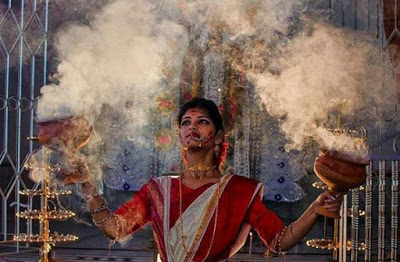
Devotees perform the Dhunuchi dance to give energy to Maa Durga. It is a vital part of the prayers for Bengalis. According to mythology, devotees had performed this dance to provide power to the Goddess when She was going on a battle against demon king Mahisasura. The sweet-smelling smoke that emits from the Dhunuchi intoxicates the devotees. Women perform Dhunuchi Naach with grace. See In Pics
Sandhi Puja
Sandhi Puja is one of the most important rituals of Durga Puja. The priest performs the puja at a specific time when Ashtami Tithi ends, and Navami tithi begins.
The Goddess is worshipped with 108 earthen lamps, 108 lotuses, a garland of 108 bel leaves. These 108 earthen lamps are kindled by devotees and presented before Devi. The 108 lotuses are reminiscent of the way Sri Ram had worshipped and invoked Durga.
During the ongoing battle between Goddess Durga and Mahishashur, Chondo and Munda had attacked the Goddess from behind. Enraged by this, the face of Goddess had turned blue, and she had opened her third eye.
The duration of the last 24 minutes of Ashtami and the opening 24 minutes of Navami is known as Sandhikhan. The puja must commence at the exact moment when Sandhikhan begins.
That is the exact time when Goddess Durga took the avatar of Goddess Chamunda and slain the associates of Mahisasur, Chando, and Munda. Devotees believe that during this time, the Goddess opens her third eye and showers her devotees with blessings.
In some places, devotees perform animal(goat/buffalo) sacrifice during Durga Puja. The priest worships the animal by uttering a variety of Mantras. And then on a single stroke, the priest beheads the head of the goat with a sword.
After offering it to Durga and other deities, the meat is cooked and distributed as Bhoga among the devotees.
Alternatively, on the ear of the goat, a small cut is made, after taking the blood from it, the goat is released.
Nowadays, in most of the pujas, animal sacrifice has stopped. Instead, the symbolic offering of vegetable substitutes like sugar cane, melon, smeared with vermillion, takes place.
The ninth day of the festival marks the homa (fire oblation) rituals. Homa, fire oblation that is performed by the construction of a fire altar and offering of various substances into the fire after reciting mantras.
Through this ritual, the priest apologizes to Lord Vishnu for any errors during puja that might have gone unnoticed.
Debi Boron On Dashami
On Dashami, married Bengali Hindu women follow the ritual of Debi Boron. First, they drape the face of the deity with betel leaf. Then, they apply Sindur on the parting line of hair and feet of Maa Durga and offer sweets to the Goddess. The same rituals follow for Goddess Saraswati and Laxmi.
Women offer sweets to Lord Karthik and Ganesha. Even the demon Mahisasura gets the same treatment. Devotees admire his courage to struggle against the insurmountable and unconquerable power of Durga.
One explanation for this ritual is that since Durga is returning to her husband’s abode, she will experience great hardships with that austere master yogi(Lord Shiva). The sweets will fatten her up for the year ahead, and the memory of this gracious treatment will encourage her to return the next year.
Sindoor Khela On Dashami
Sindoor Khela, the colorful ritual, is celebrated on the Vijaya Dashami, the last day of Durga Puja. Through this ritual, women pray for the happy and long married lives of each other. Want to know more about the ritual Sindoor Khela
Kankanjali – Paying The Debt
As per the Hindu tradition, the daughter settles the debt with her parents before leaving for her in-laws. On Doshomi(the 10th-day of Navratri), some Bonedi Bari in Kolkata follows the tradition of Kankanjali.
Most elderly married women from the family clad in a Benarasee saree, stand behind the idol. In a silver plate, some gold, a sindoor container, and rice, etc. are placed. The priest acting as a representative of the deity throws the contents of the plate on the saree of the woman.
Maa Durga Bisarjan On Dashami
The Visarjan happens on Mahadashami or the last day of the celebrations. On Dashami morning, the priest gently shakes the Kalash and the clay images, as if waking up the deities for departure. He dismisses all the other lords as well.
The priest asks the Goddess that while going back to her eternal abode, she also makes sure that the vicinity is not left without her blessings.
Ghat or Kalash Visarjan happens in the morning after the main Pujo ends. The priest immerses the mirror, which is a form of the Goddess, in water.
The festivities culminate with grand processions on Dashami, in which the clay image complex is paraded around the locality and the city with an express fanfare. There are tearful farewells.
In some of the old households (Bonedi Bari), they follow the custom of placing the idols on a bamboo platform. Men carry it on their shoulders and take it to the bank of the mighty river the Ganges. But most carry the clay images on a truck up to the river bank.
Finally, She is taken to the ghat where the Goddess is immersed in the water. She returns to her heavenly abode, mount Kailasha, as the clay image dissolves into nothingness.
And this marks the end of Durga Puja.

